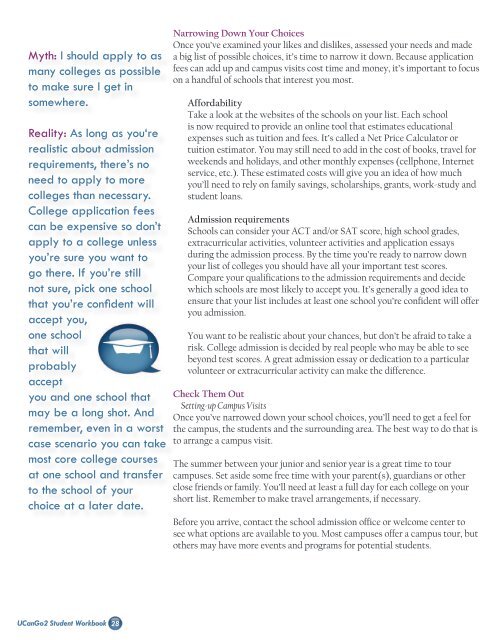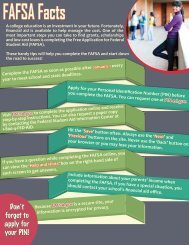Create successful ePaper yourself
Turn your PDF publications into a flip-book with our unique Google optimized e-Paper software.
Myth: I should apply to as<br />
many colleges as possible<br />
to make sure I get in<br />
somewhere.<br />
Reality: As long as you‘re<br />
realistic about admission<br />
requirements, there’s no<br />
need to apply to more<br />
colleges than necessary.<br />
College application fees<br />
can be expensive so don’t<br />
apply to a college unless<br />
you’re sure you want to<br />
go there. If you’re still<br />
not sure, pick one school<br />
that you’re confident will<br />
accept you,<br />
one school<br />
that will<br />
probably<br />
accept<br />
you and one school that<br />
may be a long shot. And<br />
remember, even in a worst<br />
case scenario you can take<br />
most core college courses<br />
at one school and transfer<br />
to the school of your<br />
choice at a later date.<br />
<strong>UCanGo2</strong> <strong>Student</strong> <strong>Workbook</strong><br />
28<br />
Narrowing Down Your Choices<br />
Once you’ve examined your likes and dislikes, assessed your needs and made<br />
a big list of possible choices, it’s time to narrow it down. Because application<br />
fees can add up and campus visits cost time and money, it’s important to focus<br />
on a handful of schools that interest you most.<br />
Affordability<br />
Take a look at the websites of the schools on your list. Each school<br />
is now required to provide an online tool that estimates educational<br />
expenses such as tuition and fees. It’s called a Net Price Calculator or<br />
tuition estimator. You may still need to add in the cost of books, travel for<br />
weekends and holidays, and other monthly expenses (cellphone, Internet<br />
service, etc.). These estimated costs will give you an idea of how much<br />
you’ll need to rely on family savings, scholarships, grants, work-study and<br />
student loans.<br />
Admission requirements<br />
<strong>School</strong>s can consider your ACT and/or SAT score, high school grades,<br />
extracurricular activities, volunteer activities and application essays<br />
during the admission process. By the time you’re ready to narrow down<br />
your list of colleges you should have all your important test scores.<br />
Compare your qualifications to the admission requirements and decide<br />
which schools are most likely to accept you. It’s generally a good idea to<br />
ensure that your list includes at least one school you’re confident will offer<br />
you admission.<br />
You want to be realistic about your chances, but don’t be afraid to take a<br />
risk. College admission is decided by real people who may be able to see<br />
beyond test scores. A great admission essay or dedication to a particular<br />
volunteer or extracurricular activity can make the difference.<br />
Check Them Out<br />
Setting-up Campus Visits<br />
Once you’ve narrowed down your school choices, you’ll need to get a feel for<br />
the campus, the students and the surrounding area. The best way to do that is<br />
to arrange a campus visit.<br />
The summer between your junior and senior year is a great time to tour<br />
campuses. Set aside some free time with your parent(s), guardians or other<br />
close friends or family. You’ll need at least a full day for each college on your<br />
short list. Remember to make travel arrangements, if necessary.<br />
Before you arrive, contact the school admission office or welcome center to<br />
see what options are available to you. Most campuses offer a campus tour, but<br />
others may have more events and programs for potential students.






